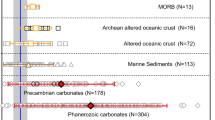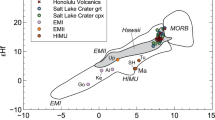Abstract
Basalts at mid-ocean ridges are generated by partial melting of the Earth’s upper mantle. As a result of this process, the upper mantle has become depleted over time in elements that are preferentially removed by melting1,2,3. Although mid-ocean-ridge basalts have traditionally been thought to reflect the chemical composition of such depleted mantle2,3,4,5,6,7, recent work has revealed the existence of domains in the upper mantle that are apparently not sampled by the basalts8. Here we present the lead (Pb), neodymium (Nd) and hafnium (Hf) isotope compositions of peridotites from the Horoman orogenic massif in Japan, which is considered to represent the residues of melting of the upper mantle. These peridotites exhibit the lowest Pb isotope ratios reported from any known mantle material, along with high Nd and Hf isotope ratios. These data suggest that chemical depletion of the peridotites occurred around a billion years ago, and that they represent ancient mantle domains that have escaped convective stirring and homogenization. We suggest that such domains—if abundant in the mantle—may constitute a hitherto unrecognized reservoir with highly unradiogenic lead.
This is a preview of subscription content, access via your institution
Access options
Subscribe to this journal
Receive 12 print issues and online access
$259.00 per year
only $21.58 per issue
Buy this article
- Purchase on Springer Link
- Instant access to full article PDF
Prices may be subject to local taxes which are calculated during checkout



Similar content being viewed by others
References
Hofmann, A. W. Chemical differentiation of the Earth: The relationship between mantle, continental crust, and oceanic crust. Earth Planet. Sci. Lett. 90, 297–314 (1988).
Workman, R. K. & Hart, S. R. Major and trace element composition of the depleted MORB mantle (DMM). Earth Planet. Sci. Lett. 231, 53–72 (2005).
Salters, J. M. & Strecke, A. Composition of the depleted mantle. Geochem. Geophys. Geosyst. 5, 10.1029/2003GC000597 (2004).
Hart, S. R. Heterogeneous mantle domains: signatures, genesis and mixing chronologies. Earth Planet. Sci. Lett. 90, 273–296 (1988).
White, W. M. Sources of oceanic basalts: Radiogenic isotope evidence. Geology 13, 115–118 (1985).
Zindler, A. & Hart, S. Chemical geodynamics. Annu. Rev. Earth Planet. Sci. 14, 493–571 (1986).
Hofmann, A. W. in The Mantle & Core (ed. Carlson, R. W.) 61–101 (Vol. 2 of Treatise in Geochem, Elsevier–Pergamon, 2003).
Liu, C-Z. et al. Ancient, highly heterogeneous mantle beneath Gakkel Ridge, Arctic Ocean. Nature 452, 311–316 (2008).
Barling, J. & Goldstein, S. L. Extreme isotopic variations in Heard Island lavas and the nature of mantle reservoirs. Nature 348, 59–62 (1990).
Dupré, B. & Allègre, C. J. Pb–Sr isotope variation in Indian Ocean basalts and mixing phenomena. Nature 303, 142–146 (1983).
Hart, S. R. A large-scale isotope anomaly in the southern hemisphere mantle. Nature 309, 753–757 (1984).
Hamelin, B. & Allègre, C. J. Lead isotope study of orogenic lherzolite massifs. Earth Planet. Sci. Lett. 91, 117–131 (1988).
Andres, M., Blichert-Toft, J. & Schilling, J.-G. Nature of the depleted upper mantle beneath the Atlantic: Evidence from normal mid-ocean ridge basalts from 79∘ N to 55∘. Earth Planet. Sci. Lett. 225, 89–103 (2004).
Niida, K. Petrology of the Horoman ultramafic rocks. J. Fac. Sci. Hokkaido Univ. 21, 61–81 (1984).
Takahashi, N. Evidence for melt segregation towards fractures in the Horoman mantle peridotite complex. Nature 359, 52–55 (1992).
Takazawa, E., Frey, F., Shimizu, N., Obata, M. & Bodinier, J. L. Geochemical evidence for melt migration and reaction in the upper mantle. Nature 359, 55–58 (1992).
Yoshikawa, M. & Nakamura, E. Geochemical evolution of the Horoman peridotite complex: Implications for melt extraction, metasomatism and compositional layering in the mantle. J. Geophys. Res. 105, 2879–2901 (2000).
Saal, A. E., Takazawa, E., Frey, F. A., Shimizu, N. & Hart, S. R. Re–Os isotopes in the Horoman peridotite: Evidence for refertilization? J. Petrol. 42, 25–37 (2001).
Shimizu, N., Warren, J. M., Frey, F. A. & Takazawa, E. The Horoman peridotite massif: An example of ancient ultraslow-spreading ridge abyssal peridotites? EOS Trans. 87, AGU fall meeting V12C07S (2006).
Plank, T. & Langumuir, C. H. The chemical composition of subducting sediments and its consequences for the crust and mantle. Chem. Geol. 145, 325–394 (1998).
Kelemen, P. B., Kikawa, E., Miller, D.J & Shipboard Scientific Party, Leg 209 Summary: Processes in a 20-km-thick conductive boundary layer beneath the Mid-Atlantic Ridge, 14∘–16∘ N. Proc. Ocean Drilling Program, Scientific Results 209, 1–33 (2007).
Walker, R. J., Prichard, H. M., Ishiwatari, A. & Pimentel, M. The osmium isotopic composition of convecting upper mantle deduced from ophiolite chromites. Geochim. Cosmochim. Acta 66, 329–345 (2002).
McDonough, W. F. & Sun, S. S. The composition of the Earth. Chem. Geol. 120, 223–253 (1995).
Stracke, A, Bizimiz, M. & Salters, V. J. M. Recycling oceanic crust: Quantitative constraints. Geochem. Geophys. Geosyst. 4, 10.1029/2001GC000223 (2003).
Hart, S. R. & Staudigel, H. in Crust/Mantle Recycling at Convergent Zones (eds Hart, S. R. & Gulen, L.) 15–28 (Kluwer–Academic, 1989).
Chauvel, C., Hofmann, A. W. & Vidal, P. HIMU-EM: The French-Polynesian connection. Earth Planet. Sci. Lett. 110, 99–119 (1992).
Rekhämper, M. & Hofmann, A. W. Recycled ocean crust and sediment in Indian Ocean MORB. Earth Planet. Sci. Lett. 147, 93–106 (1997).
Hauri, E. H. & Hart, S. R. Re–Os Isotope systematics of HIMU and EMII oceanic island basalts from the South-Pacific Ocean. Earth Planet. Sci. Lett. 114, 353–371 (1993).
Acknowledgements
We thank T. Moriguti, K. Kobayashi, T. Yokoyama and other colleagues for discussion and analytical help. K. Ozawa, K. Kunugiza, T. Usui and T. Moriyama are acknowledged for help in collecting samples. R. Tanaka and C. Sakaguchi are thanked for help in X-ray fluorescence and Sm–Nd analysis respectively. We are grateful to B. Mysen and K. Yamashita for improving the manuscript and A. W. Hofmann and F. Frey for constructive comments. This study was supported by the programme of the ‘Centre of Excellence for the 21st Century in Japan’ from MEXT to E.N. and Grants-in-aid from JSPS to A.M.
Author information
Authors and Affiliations
Contributions
E.N. initiated and formulated this project. S.P.K.M. carried out the project and wrote the paper as part of his PhD thesis. All authors contributed to analysis of the samples and interpretation of the results.
Corresponding authors
Supplementary information
Supplementary Information, Fig. S1
Supplementary Information (PDF 284 kb)
Rights and permissions
About this article
Cite this article
Malaviarachchi, S., Makishima, A., Tanimoto, M. et al. Highly unradiogenic lead isotope ratios from the Horoman peridotite in Japan. Nature Geosci 1, 859–863 (2008). https://doi.org/10.1038/ngeo363
Received:
Accepted:
Published:
Issue Date:
DOI: https://doi.org/10.1038/ngeo363
This article is cited by
-
Circa 1 Ga sub-seafloor hydrothermal alteration imprinted on the Horoman peridotite massif
Scientific Reports (2018)
-
A highly unradiogenic lead isotopic signature revealed by volcanic rocks from the East Pacific Rise
Nature Communications (2014)
-
Unradiogenic lead in Earth’s upper mantle
Nature Geoscience (2012)
-
The enduring lead paradox
Nature Geoscience (2008)



